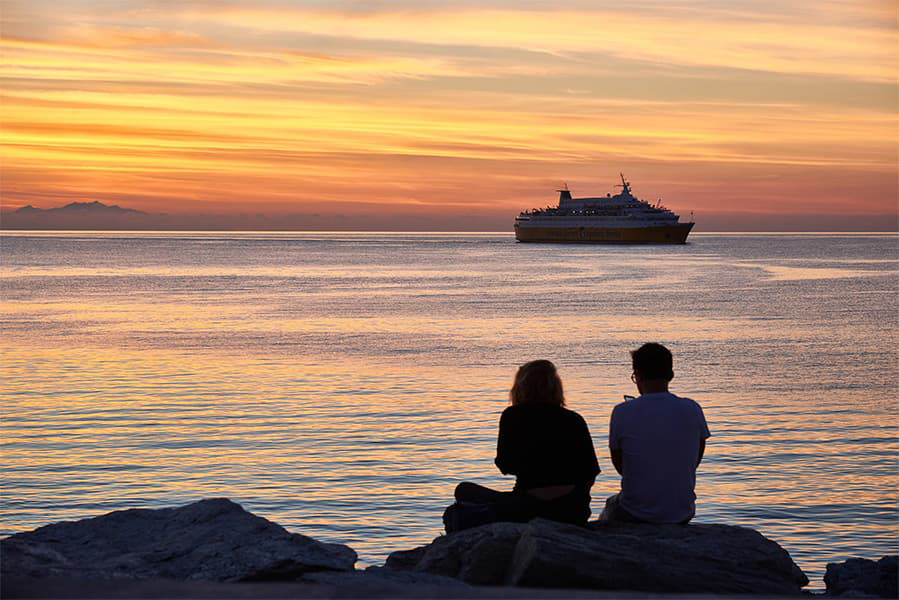Guernsey - Jersey (St Helier)
Ferry to Jersey
Guernsey - Jersey (St Helier)
Ferry to Jersey

Depending on the season their are usually 2 daily and 7 weekly sailings between Guernsey and Jersey (St Helier). 4 ferry operators provide the ferries from Guernsey to Jersey (St Helier), Brittany Ferries, DFDS Seaways, Manche Iles Express & Islands Unlimited. Guernsey Jersey (St Helier) ferries take around 1 hour 10 minutes. The ferry costs between $95 and $533, depending on ticket details. Prices exclude any service fees. Ferry timetables change seasonally, use our Deal Finder to get live pricing and availability for ferries from Guernsey to Jersey (St Helier).
The earliest Guernsey Jersey (St Helier) ferry typically departs Guernsey at about 05:45 and the last ferry usually leaves at 20:00.
Ferries from Guernsey to Jersey (St Helier) sail in around 1 hour 10 minutes. The fastest ferry is approximately 1 hour. Ferry duration can vary by ferry provider and can be impacted by weather conditions.
There is 7 weekly sailings from Guernsey to Jersey (St Helier) provided by Brittany Ferries, DFDS Seaways, Manche Iles Express & Islands Unlimited. Timetables can change from season to season.
Brittany Ferries provide 1 sailing weekly. DFDS Seaways provide 1 sailing weekly. Manche Iles Express provide 1 sailing weekly. Islands Unlimited provide 9 sailings weekly.
The price of a ferry from Guernsey to Jersey (St Helier) typically range between $95* and $533*. On average the Guernsey Jersey (St Helier) ferry is $210.10*. The cheapest Guernsey Jersey (St Helier) ferry prices start from $95*. The average price for a foot passenger is $185*. The average price for a car is $332*.
Pricing will vary depending on number of passengers, vehicle type, route and sailing times. Pricing is taken from searches over last 30 days and exclusive of service fees, last updated 1 December 2025.
The distance between Guernsey to Jersey (St Helier) is approximately 34 miles (55km) or 30 nautical miles.
Yes, Guernsey Jersey (St Helier) ferries allow cars onboard with Brittany Ferries & DFDS Seaways between Guernsey and Jersey (St Helier). To view car ferry tickets and prices between Guernsey and Jersey (St Helier) use our Deal Finder.
Brittany Ferries, DFDS Seaways, Manche Iles Express & Islands Unlimited allow foot passengers on Guernsey Jersey (St Helier) ferries.
Brittany Ferries allow pets on ferries from Guernsey to Jersey (St Helier). Please also note that your pet may have to stay in the vehicle during the journey.
More routes than anyone else.

Compare fares, times & routes in one place.
Change plans easily with flexi tickets.

Book e-tickets & manage trips in-app.
Live ship tracking & real-time updates.

Top-rated customer support when you need it.
| Guernsey - Jersey (St Helier) Ferry Route summary | ||
|---|---|---|
| Departure Destination | Guernsey | |
| Destination | Jersey | |
| No. of Operators | 4 | |
| Operators | Brittany Ferries, DFDS Seaways, Manche Iles Express & Islands Unlimited | |
| Average Price | $210 | |
| Average Daily Sailings | 2 | |
| Average Weekly Sailings | 7 | |
| Average Sailing Duration | 1 h 10 m | |
| Fastest Sailing Duration | 1 h | |
| First Ferry | 05:45 | |
| Last Ferry | 20:00 | |
| Distance | 30 Nautical Miles | |
* Prices subject to change, pricing is taken from last 30 days, last updated 1 December 2025.
Forming one of the Channel Islands in the English Channel, the island of Guernsey is a possession of the British Crown and lies around 50 km to the west of the Normandy coast in France and 120 km to the south of Weymouth, on the south coast of England. The island has a milder climate than much of the UK which is why the island's inhabitants seem to make the most of the outdoors. There are beautiful beaches to visit, cliff paths to trek along and some island hopping to be had. During the summer months, a spot of 'al fresco' dining may even be possible. Guernsey's capital, St Peter Port, is characterised by its pretty cobbled streets and beautiful marina.
There are many things for visitors to see and do on the island. The island's spectacular coastline and countryside provide the backdrop to pursue a wide range of outdoor activities including coasteering, climbing, cycling, diving, kayaking, surfing, windsurfing and sailing.
The island's port is also in St Peter Port and is only a 10 minute walk to the city centre. The ferry terminal provides services to other Channel Islands, France and the UK mainland. The terminal building has many shops and restaurants.
The town of St Helier is located on the island of Jersey which is one of the Channel Islands that are in the English Channel. St Helier is one of twelve parishes on the island and is the island's capital and largest town, with a population of around 30,000. The town takes its name from the 6th century Ascetic hermit, Helier, or Helerius. The hermit's feast day is marked by an annual municipal and ecumenical pilgrimage to the Hermitage on the 16th of July.
Popular with visitors is the Central Market, which is an indoor market on Beresford Street, which was opened in 1882 and has been declared a Site of Special Interest. The market has Victorian architecture on show which includes cast iron structures and an ornamental fountain.
Passenger facilities at the town's port include cafes, shops and duty free outlets. Ferry services operating from the port depart to destinations in France and England along with services to Guernsey. services to the UK travel to Poole, Weymouth and Portsmouth and to St Malo in France.